BM414 Financial Decision Making: Financial Analysis of Panini Ltd
VerifiedAdded on 2023/06/11
|14
|4343
|343
Report
AI Summary
This report presents a comprehensive financial analysis of Panini Ltd, a medium-sized bread-making company. Task 1 details the functions of both the Accounting and Finance departments, including financial accounting, management accounting, tax, auditing, investment, financing, dividend, and working capital functions. It also explores potential sources of finance for the company's expansion, such as commercial banks and owner's capital. Task 2 involves the calculation and analysis of various financial ratios for the years 2018 and 2019, including gross profit margin, operating profit margin, return on capital employed, current ratio, quick ratio, inventory turnover days, debtor’s collection period, and creditor’s collection period, providing insights into the company's financial performance and liquidity.

Module Code: BM414
Module Title: Financial Decision Making
Module Title: Financial Decision Making
Paraphrase This Document
Need a fresh take? Get an instant paraphrase of this document with our AI Paraphraser
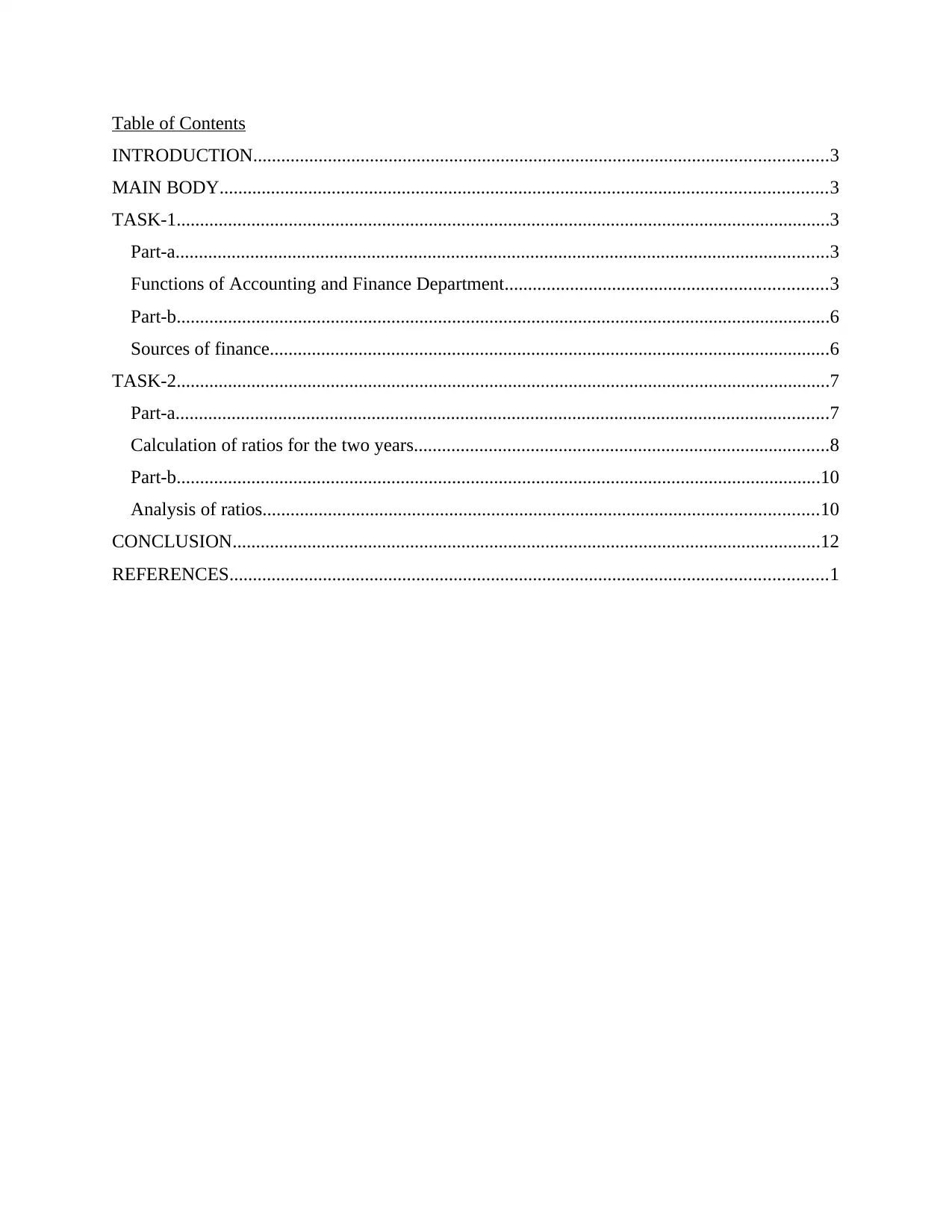
Table of Contents
INTRODUCTION...........................................................................................................................3
MAIN BODY..................................................................................................................................3
TASK-1............................................................................................................................................3
Part-a............................................................................................................................................3
Functions of Accounting and Finance Department.....................................................................3
Part-b............................................................................................................................................6
Sources of finance........................................................................................................................6
TASK-2............................................................................................................................................7
Part-a............................................................................................................................................7
Calculation of ratios for the two years.........................................................................................8
Part-b..........................................................................................................................................10
Analysis of ratios.......................................................................................................................10
CONCLUSION..............................................................................................................................12
REFERENCES................................................................................................................................1
INTRODUCTION...........................................................................................................................3
MAIN BODY..................................................................................................................................3
TASK-1............................................................................................................................................3
Part-a............................................................................................................................................3
Functions of Accounting and Finance Department.....................................................................3
Part-b............................................................................................................................................6
Sources of finance........................................................................................................................6
TASK-2............................................................................................................................................7
Part-a............................................................................................................................................7
Calculation of ratios for the two years.........................................................................................8
Part-b..........................................................................................................................................10
Analysis of ratios.......................................................................................................................10
CONCLUSION..............................................................................................................................12
REFERENCES................................................................................................................................1
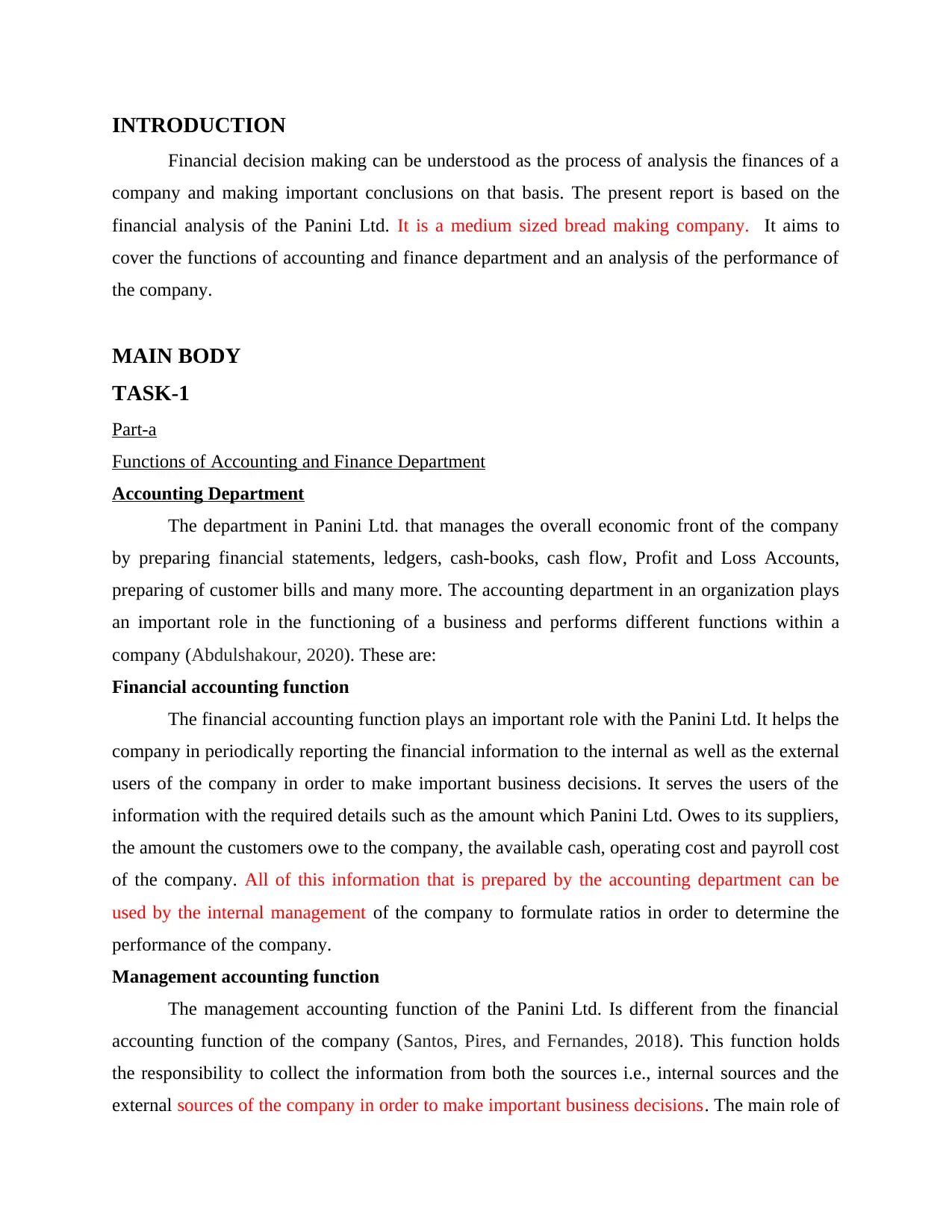
INTRODUCTION
Financial decision making can be understood as the process of analysis the finances of a
company and making important conclusions on that basis. The present report is based on the
financial analysis of the Panini Ltd. It is a medium sized bread making company. It aims to
cover the functions of accounting and finance department and an analysis of the performance of
the company.
MAIN BODY
TASK-1
Part-a
Functions of Accounting and Finance Department
Accounting Department
The department in Panini Ltd. that manages the overall economic front of the company
by preparing financial statements, ledgers, cash-books, cash flow, Profit and Loss Accounts,
preparing of customer bills and many more. The accounting department in an organization plays
an important role in the functioning of a business and performs different functions within a
company (Abdulshakour, 2020). These are:
Financial accounting function
The financial accounting function plays an important role with the Panini Ltd. It helps the
company in periodically reporting the financial information to the internal as well as the external
users of the company in order to make important business decisions. It serves the users of the
information with the required details such as the amount which Panini Ltd. Owes to its suppliers,
the amount the customers owe to the company, the available cash, operating cost and payroll cost
of the company. All of this information that is prepared by the accounting department can be
used by the internal management of the company to formulate ratios in order to determine the
performance of the company.
Management accounting function
The management accounting function of the Panini Ltd. Is different from the financial
accounting function of the company (Santos, Pires, and Fernandes, 2018). This function holds
the responsibility to collect the information from both the sources i.e., internal sources and the
external sources of the company in order to make important business decisions. The main role of
Financial decision making can be understood as the process of analysis the finances of a
company and making important conclusions on that basis. The present report is based on the
financial analysis of the Panini Ltd. It is a medium sized bread making company. It aims to
cover the functions of accounting and finance department and an analysis of the performance of
the company.
MAIN BODY
TASK-1
Part-a
Functions of Accounting and Finance Department
Accounting Department
The department in Panini Ltd. that manages the overall economic front of the company
by preparing financial statements, ledgers, cash-books, cash flow, Profit and Loss Accounts,
preparing of customer bills and many more. The accounting department in an organization plays
an important role in the functioning of a business and performs different functions within a
company (Abdulshakour, 2020). These are:
Financial accounting function
The financial accounting function plays an important role with the Panini Ltd. It helps the
company in periodically reporting the financial information to the internal as well as the external
users of the company in order to make important business decisions. It serves the users of the
information with the required details such as the amount which Panini Ltd. Owes to its suppliers,
the amount the customers owe to the company, the available cash, operating cost and payroll cost
of the company. All of this information that is prepared by the accounting department can be
used by the internal management of the company to formulate ratios in order to determine the
performance of the company.
Management accounting function
The management accounting function of the Panini Ltd. Is different from the financial
accounting function of the company (Santos, Pires, and Fernandes, 2018). This function holds
the responsibility to collect the information from both the sources i.e., internal sources and the
external sources of the company in order to make important business decisions. The main role of
⊘ This is a preview!⊘
Do you want full access?
Subscribe today to unlock all pages.

Trusted by 1+ million students worldwide
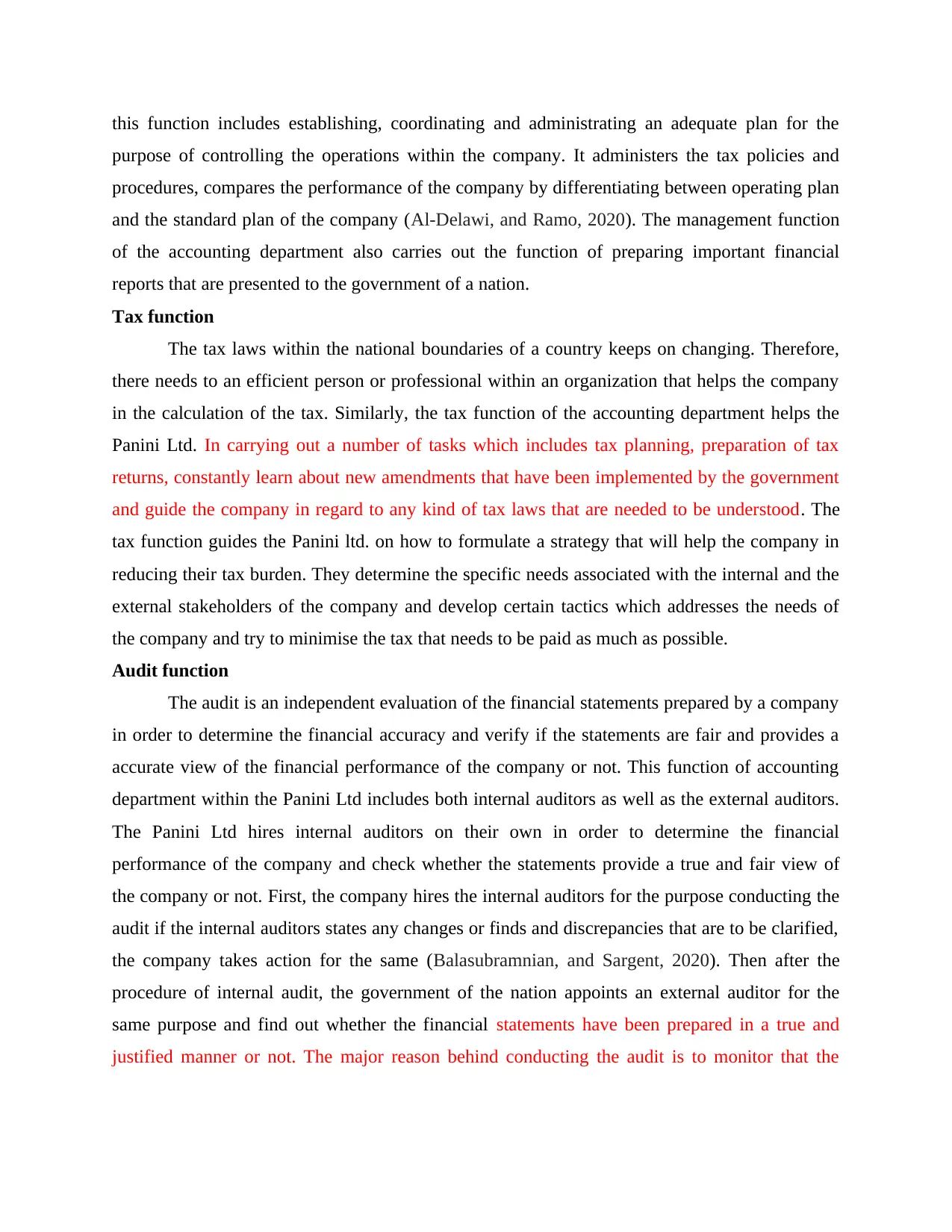
this function includes establishing, coordinating and administrating an adequate plan for the
purpose of controlling the operations within the company. It administers the tax policies and
procedures, compares the performance of the company by differentiating between operating plan
and the standard plan of the company (Al-Delawi, and Ramo, 2020). The management function
of the accounting department also carries out the function of preparing important financial
reports that are presented to the government of a nation.
Tax function
The tax laws within the national boundaries of a country keeps on changing. Therefore,
there needs to an efficient person or professional within an organization that helps the company
in the calculation of the tax. Similarly, the tax function of the accounting department helps the
Panini Ltd. In carrying out a number of tasks which includes tax planning, preparation of tax
returns, constantly learn about new amendments that have been implemented by the government
and guide the company in regard to any kind of tax laws that are needed to be understood. The
tax function guides the Panini ltd. on how to formulate a strategy that will help the company in
reducing their tax burden. They determine the specific needs associated with the internal and the
external stakeholders of the company and develop certain tactics which addresses the needs of
the company and try to minimise the tax that needs to be paid as much as possible.
Audit function
The audit is an independent evaluation of the financial statements prepared by a company
in order to determine the financial accuracy and verify if the statements are fair and provides a
accurate view of the financial performance of the company or not. This function of accounting
department within the Panini Ltd includes both internal auditors as well as the external auditors.
The Panini Ltd hires internal auditors on their own in order to determine the financial
performance of the company and check whether the statements provide a true and fair view of
the company or not. First, the company hires the internal auditors for the purpose conducting the
audit if the internal auditors states any changes or finds and discrepancies that are to be clarified,
the company takes action for the same (Balasubramnian, and Sargent, 2020). Then after the
procedure of internal audit, the government of the nation appoints an external auditor for the
same purpose and find out whether the financial statements have been prepared in a true and
justified manner or not. The major reason behind conducting the audit is to monitor that the
purpose of controlling the operations within the company. It administers the tax policies and
procedures, compares the performance of the company by differentiating between operating plan
and the standard plan of the company (Al-Delawi, and Ramo, 2020). The management function
of the accounting department also carries out the function of preparing important financial
reports that are presented to the government of a nation.
Tax function
The tax laws within the national boundaries of a country keeps on changing. Therefore,
there needs to an efficient person or professional within an organization that helps the company
in the calculation of the tax. Similarly, the tax function of the accounting department helps the
Panini Ltd. In carrying out a number of tasks which includes tax planning, preparation of tax
returns, constantly learn about new amendments that have been implemented by the government
and guide the company in regard to any kind of tax laws that are needed to be understood. The
tax function guides the Panini ltd. on how to formulate a strategy that will help the company in
reducing their tax burden. They determine the specific needs associated with the internal and the
external stakeholders of the company and develop certain tactics which addresses the needs of
the company and try to minimise the tax that needs to be paid as much as possible.
Audit function
The audit is an independent evaluation of the financial statements prepared by a company
in order to determine the financial accuracy and verify if the statements are fair and provides a
accurate view of the financial performance of the company or not. This function of accounting
department within the Panini Ltd includes both internal auditors as well as the external auditors.
The Panini Ltd hires internal auditors on their own in order to determine the financial
performance of the company and check whether the statements provide a true and fair view of
the company or not. First, the company hires the internal auditors for the purpose conducting the
audit if the internal auditors states any changes or finds and discrepancies that are to be clarified,
the company takes action for the same (Balasubramnian, and Sargent, 2020). Then after the
procedure of internal audit, the government of the nation appoints an external auditor for the
same purpose and find out whether the financial statements have been prepared in a true and
justified manner or not. The major reason behind conducting the audit is to monitor that the
Paraphrase This Document
Need a fresh take? Get an instant paraphrase of this document with our AI Paraphraser
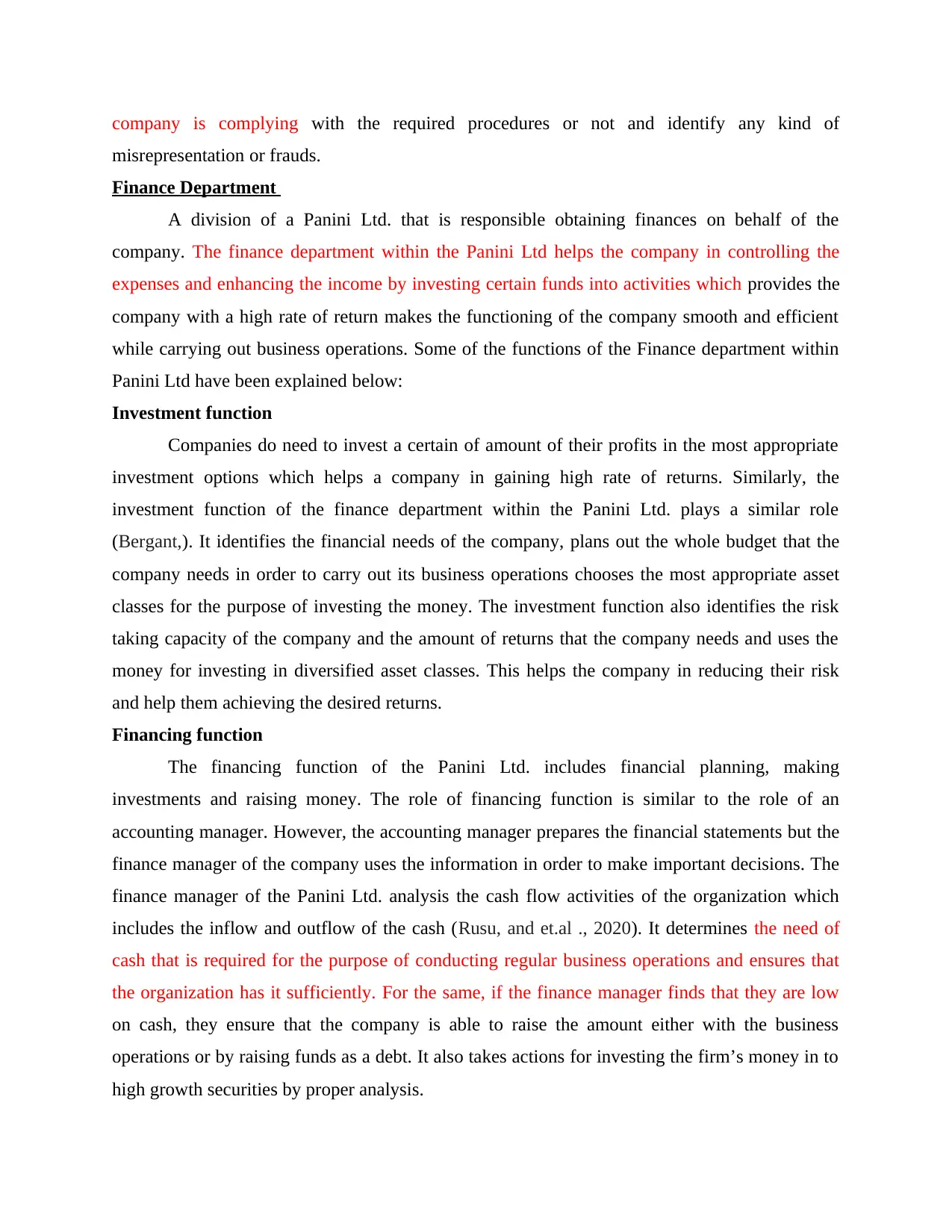
company is complying with the required procedures or not and identify any kind of
misrepresentation or frauds.
Finance Department
A division of a Panini Ltd. that is responsible obtaining finances on behalf of the
company. The finance department within the Panini Ltd helps the company in controlling the
expenses and enhancing the income by investing certain funds into activities which provides the
company with a high rate of return makes the functioning of the company smooth and efficient
while carrying out business operations. Some of the functions of the Finance department within
Panini Ltd have been explained below:
Investment function
Companies do need to invest a certain of amount of their profits in the most appropriate
investment options which helps a company in gaining high rate of returns. Similarly, the
investment function of the finance department within the Panini Ltd. plays a similar role
(Bergant,). It identifies the financial needs of the company, plans out the whole budget that the
company needs in order to carry out its business operations chooses the most appropriate asset
classes for the purpose of investing the money. The investment function also identifies the risk
taking capacity of the company and the amount of returns that the company needs and uses the
money for investing in diversified asset classes. This helps the company in reducing their risk
and help them achieving the desired returns.
Financing function
The financing function of the Panini Ltd. includes financial planning, making
investments and raising money. The role of financing function is similar to the role of an
accounting manager. However, the accounting manager prepares the financial statements but the
finance manager of the company uses the information in order to make important decisions. The
finance manager of the Panini Ltd. analysis the cash flow activities of the organization which
includes the inflow and outflow of the cash (Rusu, and et.al ., 2020). It determines the need of
cash that is required for the purpose of conducting regular business operations and ensures that
the organization has it sufficiently. For the same, if the finance manager finds that they are low
on cash, they ensure that the company is able to raise the amount either with the business
operations or by raising funds as a debt. It also takes actions for investing the firm’s money in to
high growth securities by proper analysis.
misrepresentation or frauds.
Finance Department
A division of a Panini Ltd. that is responsible obtaining finances on behalf of the
company. The finance department within the Panini Ltd helps the company in controlling the
expenses and enhancing the income by investing certain funds into activities which provides the
company with a high rate of return makes the functioning of the company smooth and efficient
while carrying out business operations. Some of the functions of the Finance department within
Panini Ltd have been explained below:
Investment function
Companies do need to invest a certain of amount of their profits in the most appropriate
investment options which helps a company in gaining high rate of returns. Similarly, the
investment function of the finance department within the Panini Ltd. plays a similar role
(Bergant,). It identifies the financial needs of the company, plans out the whole budget that the
company needs in order to carry out its business operations chooses the most appropriate asset
classes for the purpose of investing the money. The investment function also identifies the risk
taking capacity of the company and the amount of returns that the company needs and uses the
money for investing in diversified asset classes. This helps the company in reducing their risk
and help them achieving the desired returns.
Financing function
The financing function of the Panini Ltd. includes financial planning, making
investments and raising money. The role of financing function is similar to the role of an
accounting manager. However, the accounting manager prepares the financial statements but the
finance manager of the company uses the information in order to make important decisions. The
finance manager of the Panini Ltd. analysis the cash flow activities of the organization which
includes the inflow and outflow of the cash (Rusu, and et.al ., 2020). It determines the need of
cash that is required for the purpose of conducting regular business operations and ensures that
the organization has it sufficiently. For the same, if the finance manager finds that they are low
on cash, they ensure that the company is able to raise the amount either with the business
operations or by raising funds as a debt. It also takes actions for investing the firm’s money in to
high growth securities by proper analysis.
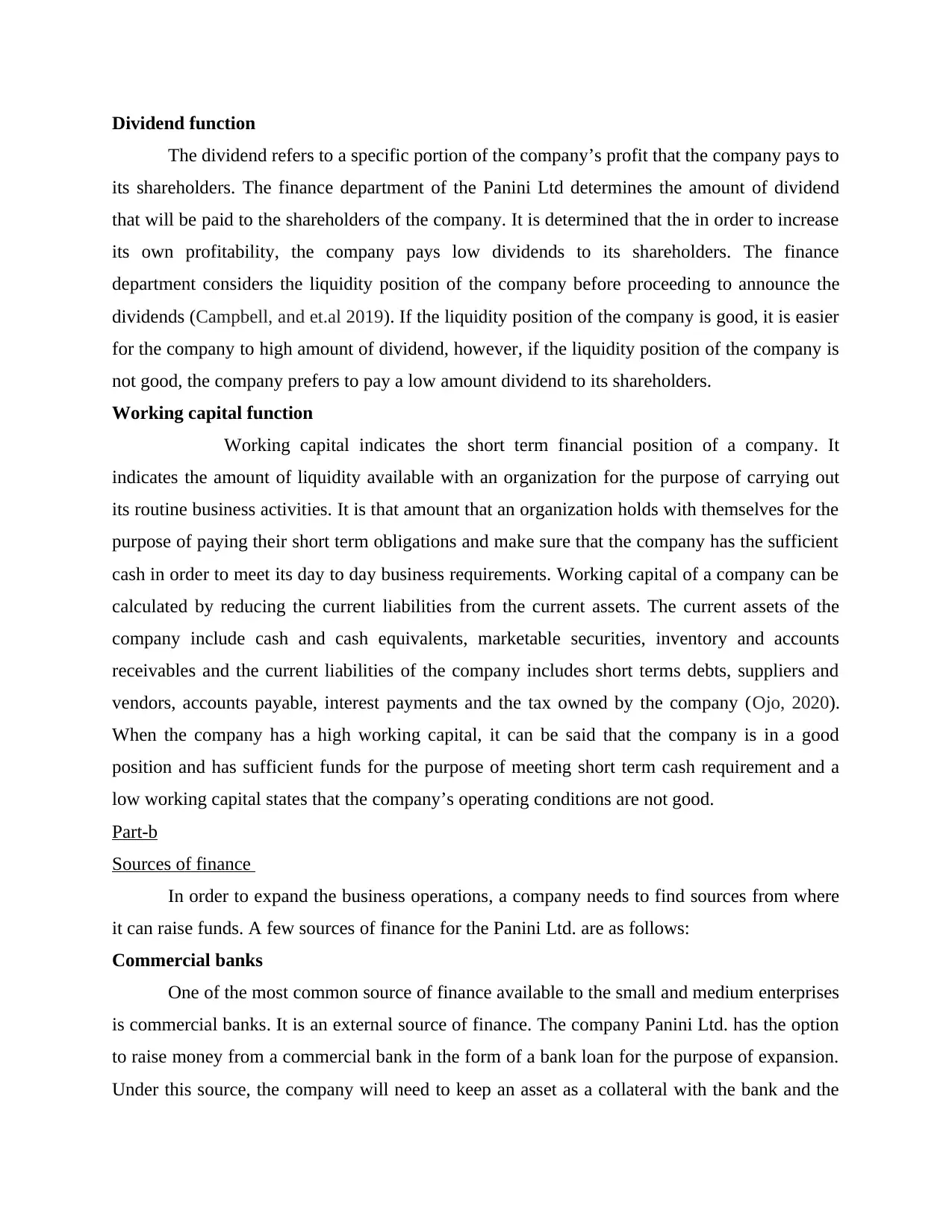
Dividend function
The dividend refers to a specific portion of the company’s profit that the company pays to
its shareholders. The finance department of the Panini Ltd determines the amount of dividend
that will be paid to the shareholders of the company. It is determined that the in order to increase
its own profitability, the company pays low dividends to its shareholders. The finance
department considers the liquidity position of the company before proceeding to announce the
dividends (Campbell, and et.al 2019). If the liquidity position of the company is good, it is easier
for the company to high amount of dividend, however, if the liquidity position of the company is
not good, the company prefers to pay a low amount dividend to its shareholders.
Working capital function
Working capital indicates the short term financial position of a company. It
indicates the amount of liquidity available with an organization for the purpose of carrying out
its routine business activities. It is that amount that an organization holds with themselves for the
purpose of paying their short term obligations and make sure that the company has the sufficient
cash in order to meet its day to day business requirements. Working capital of a company can be
calculated by reducing the current liabilities from the current assets. The current assets of the
company include cash and cash equivalents, marketable securities, inventory and accounts
receivables and the current liabilities of the company includes short terms debts, suppliers and
vendors, accounts payable, interest payments and the tax owned by the company (Ojo, 2020).
When the company has a high working capital, it can be said that the company is in a good
position and has sufficient funds for the purpose of meeting short term cash requirement and a
low working capital states that the company’s operating conditions are not good.
Part-b
Sources of finance
In order to expand the business operations, a company needs to find sources from where
it can raise funds. A few sources of finance for the Panini Ltd. are as follows:
Commercial banks
One of the most common source of finance available to the small and medium enterprises
is commercial banks. It is an external source of finance. The company Panini Ltd. has the option
to raise money from a commercial bank in the form of a bank loan for the purpose of expansion.
Under this source, the company will need to keep an asset as a collateral with the bank and the
The dividend refers to a specific portion of the company’s profit that the company pays to
its shareholders. The finance department of the Panini Ltd determines the amount of dividend
that will be paid to the shareholders of the company. It is determined that the in order to increase
its own profitability, the company pays low dividends to its shareholders. The finance
department considers the liquidity position of the company before proceeding to announce the
dividends (Campbell, and et.al 2019). If the liquidity position of the company is good, it is easier
for the company to high amount of dividend, however, if the liquidity position of the company is
not good, the company prefers to pay a low amount dividend to its shareholders.
Working capital function
Working capital indicates the short term financial position of a company. It
indicates the amount of liquidity available with an organization for the purpose of carrying out
its routine business activities. It is that amount that an organization holds with themselves for the
purpose of paying their short term obligations and make sure that the company has the sufficient
cash in order to meet its day to day business requirements. Working capital of a company can be
calculated by reducing the current liabilities from the current assets. The current assets of the
company include cash and cash equivalents, marketable securities, inventory and accounts
receivables and the current liabilities of the company includes short terms debts, suppliers and
vendors, accounts payable, interest payments and the tax owned by the company (Ojo, 2020).
When the company has a high working capital, it can be said that the company is in a good
position and has sufficient funds for the purpose of meeting short term cash requirement and a
low working capital states that the company’s operating conditions are not good.
Part-b
Sources of finance
In order to expand the business operations, a company needs to find sources from where
it can raise funds. A few sources of finance for the Panini Ltd. are as follows:
Commercial banks
One of the most common source of finance available to the small and medium enterprises
is commercial banks. It is an external source of finance. The company Panini Ltd. has the option
to raise money from a commercial bank in the form of a bank loan for the purpose of expansion.
Under this source, the company will need to keep an asset as a collateral with the bank and the
⊘ This is a preview!⊘
Do you want full access?
Subscribe today to unlock all pages.

Trusted by 1+ million students worldwide
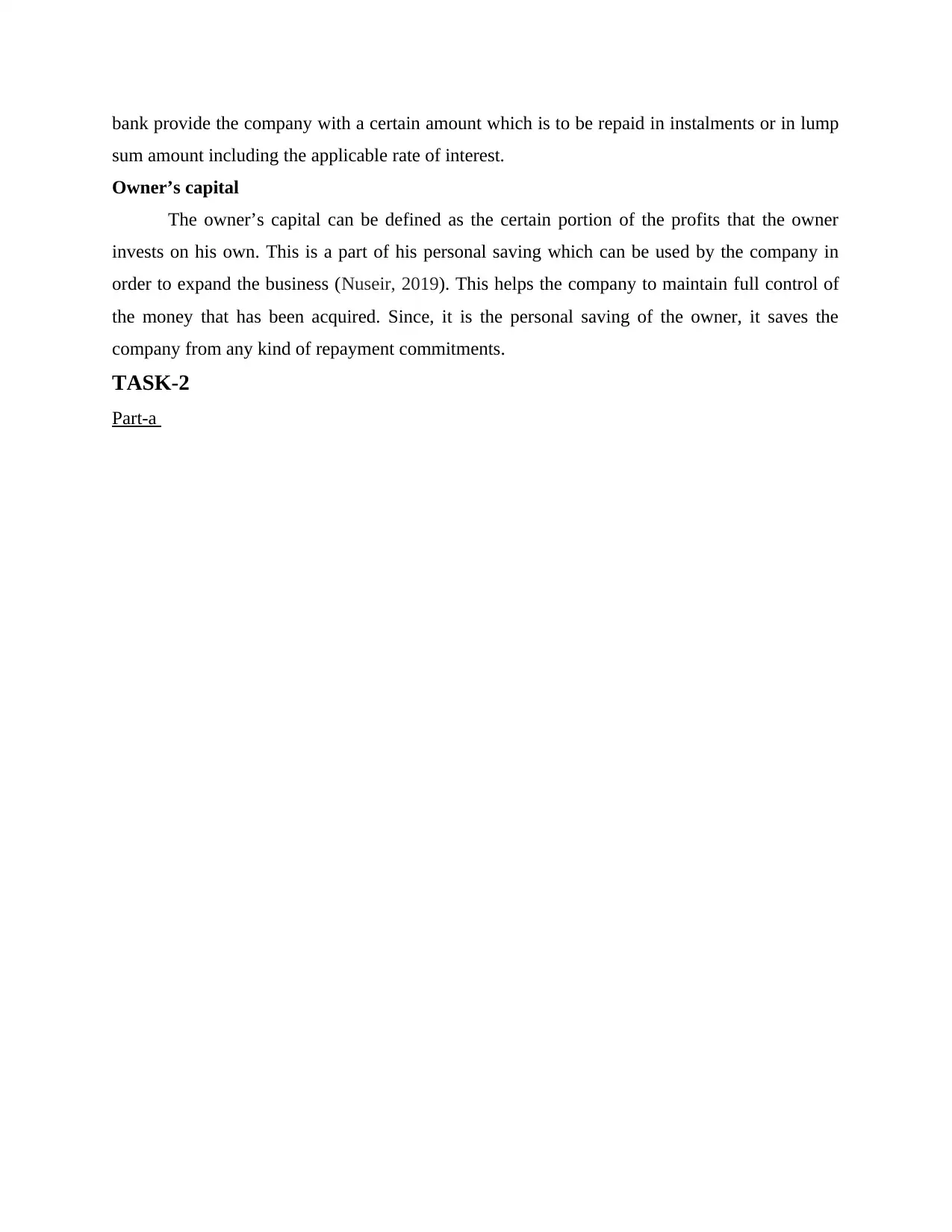
bank provide the company with a certain amount which is to be repaid in instalments or in lump
sum amount including the applicable rate of interest.
Owner’s capital
The owner’s capital can be defined as the certain portion of the profits that the owner
invests on his own. This is a part of his personal saving which can be used by the company in
order to expand the business (Nuseir, 2019). This helps the company to maintain full control of
the money that has been acquired. Since, it is the personal saving of the owner, it saves the
company from any kind of repayment commitments.
TASK-2
Part-a
sum amount including the applicable rate of interest.
Owner’s capital
The owner’s capital can be defined as the certain portion of the profits that the owner
invests on his own. This is a part of his personal saving which can be used by the company in
order to expand the business (Nuseir, 2019). This helps the company to maintain full control of
the money that has been acquired. Since, it is the personal saving of the owner, it saves the
company from any kind of repayment commitments.
TASK-2
Part-a
Paraphrase This Document
Need a fresh take? Get an instant paraphrase of this document with our AI Paraphraser
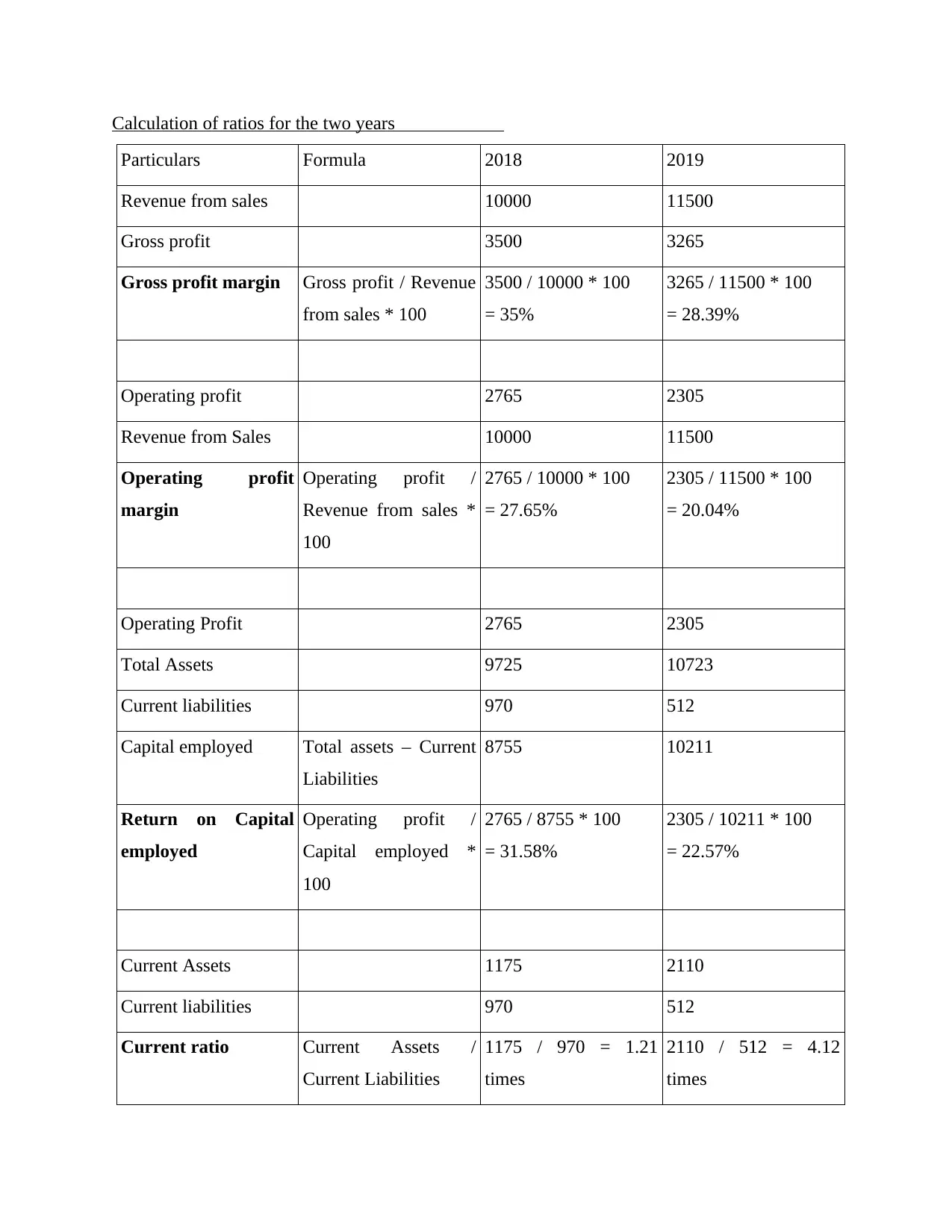
Calculation of ratios for the two years
Particulars Formula 2018 2019
Revenue from sales 10000 11500
Gross profit 3500 3265
Gross profit margin Gross profit / Revenue
from sales * 100
3500 / 10000 * 100
= 35%
3265 / 11500 * 100
= 28.39%
Operating profit 2765 2305
Revenue from Sales 10000 11500
Operating profit
margin
Operating profit /
Revenue from sales *
100
2765 / 10000 * 100
= 27.65%
2305 / 11500 * 100
= 20.04%
Operating Profit 2765 2305
Total Assets 9725 10723
Current liabilities 970 512
Capital employed Total assets – Current
Liabilities
8755 10211
Return on Capital
employed
Operating profit /
Capital employed *
100
2765 / 8755 * 100
= 31.58%
2305 / 10211 * 100
= 22.57%
Current Assets 1175 2110
Current liabilities 970 512
Current ratio Current Assets /
Current Liabilities
1175 / 970 = 1.21
times
2110 / 512 = 4.12
times
Particulars Formula 2018 2019
Revenue from sales 10000 11500
Gross profit 3500 3265
Gross profit margin Gross profit / Revenue
from sales * 100
3500 / 10000 * 100
= 35%
3265 / 11500 * 100
= 28.39%
Operating profit 2765 2305
Revenue from Sales 10000 11500
Operating profit
margin
Operating profit /
Revenue from sales *
100
2765 / 10000 * 100
= 27.65%
2305 / 11500 * 100
= 20.04%
Operating Profit 2765 2305
Total Assets 9725 10723
Current liabilities 970 512
Capital employed Total assets – Current
Liabilities
8755 10211
Return on Capital
employed
Operating profit /
Capital employed *
100
2765 / 8755 * 100
= 31.58%
2305 / 10211 * 100
= 22.57%
Current Assets 1175 2110
Current liabilities 970 512
Current ratio Current Assets /
Current Liabilities
1175 / 970 = 1.21
times
2110 / 512 = 4.12
times
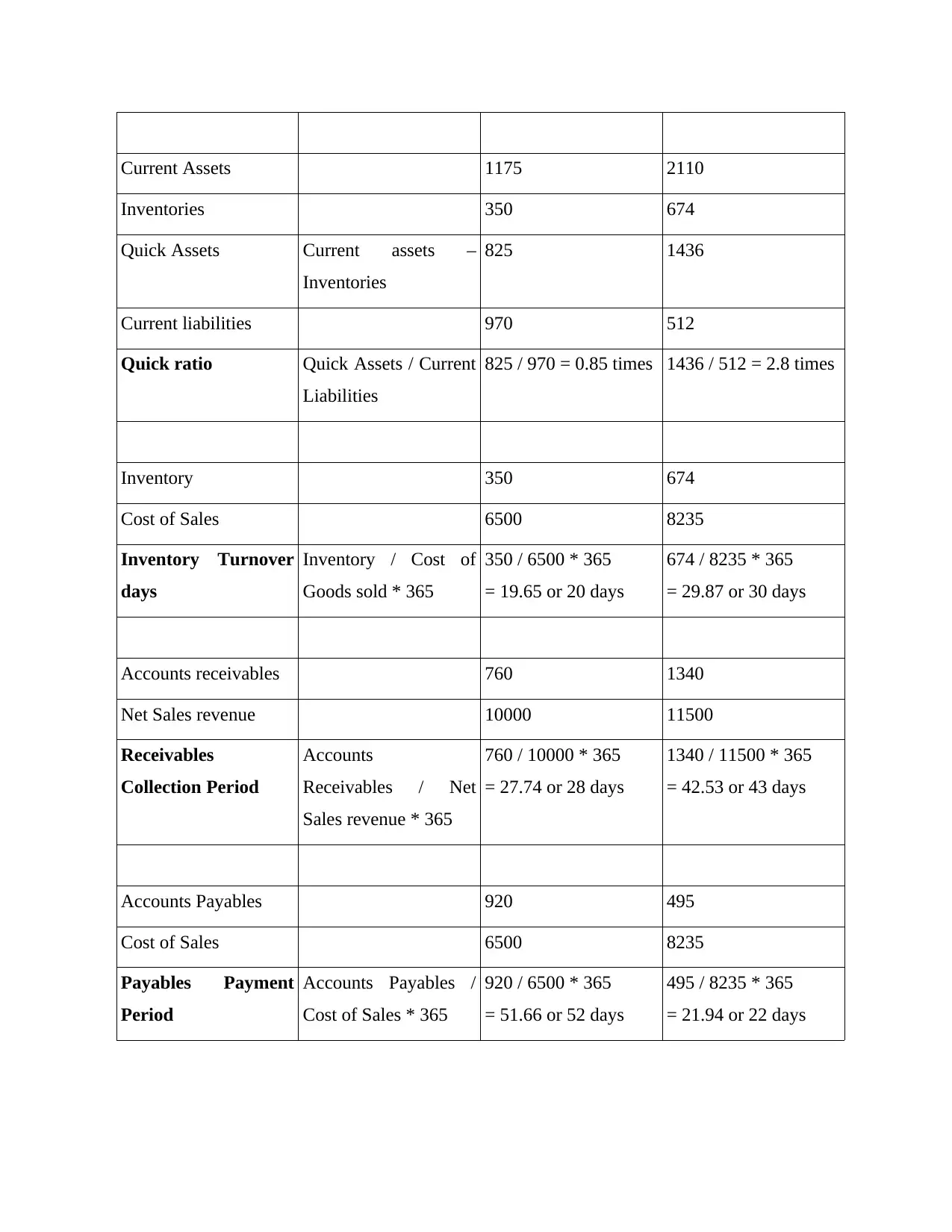
Current Assets 1175 2110
Inventories 350 674
Quick Assets Current assets –
Inventories
825 1436
Current liabilities 970 512
Quick ratio Quick Assets / Current
Liabilities
825 / 970 = 0.85 times 1436 / 512 = 2.8 times
Inventory 350 674
Cost of Sales 6500 8235
Inventory Turnover
days
Inventory / Cost of
Goods sold * 365
350 / 6500 * 365
= 19.65 or 20 days
674 / 8235 * 365
= 29.87 or 30 days
Accounts receivables 760 1340
Net Sales revenue 10000 11500
Receivables
Collection Period
Accounts
Receivables / Net
Sales revenue * 365
760 / 10000 * 365
= 27.74 or 28 days
1340 / 11500 * 365
= 42.53 or 43 days
Accounts Payables 920 495
Cost of Sales 6500 8235
Payables Payment
Period
Accounts Payables /
Cost of Sales * 365
920 / 6500 * 365
= 51.66 or 52 days
495 / 8235 * 365
= 21.94 or 22 days
Inventories 350 674
Quick Assets Current assets –
Inventories
825 1436
Current liabilities 970 512
Quick ratio Quick Assets / Current
Liabilities
825 / 970 = 0.85 times 1436 / 512 = 2.8 times
Inventory 350 674
Cost of Sales 6500 8235
Inventory Turnover
days
Inventory / Cost of
Goods sold * 365
350 / 6500 * 365
= 19.65 or 20 days
674 / 8235 * 365
= 29.87 or 30 days
Accounts receivables 760 1340
Net Sales revenue 10000 11500
Receivables
Collection Period
Accounts
Receivables / Net
Sales revenue * 365
760 / 10000 * 365
= 27.74 or 28 days
1340 / 11500 * 365
= 42.53 or 43 days
Accounts Payables 920 495
Cost of Sales 6500 8235
Payables Payment
Period
Accounts Payables /
Cost of Sales * 365
920 / 6500 * 365
= 51.66 or 52 days
495 / 8235 * 365
= 21.94 or 22 days
⊘ This is a preview!⊘
Do you want full access?
Subscribe today to unlock all pages.

Trusted by 1+ million students worldwide
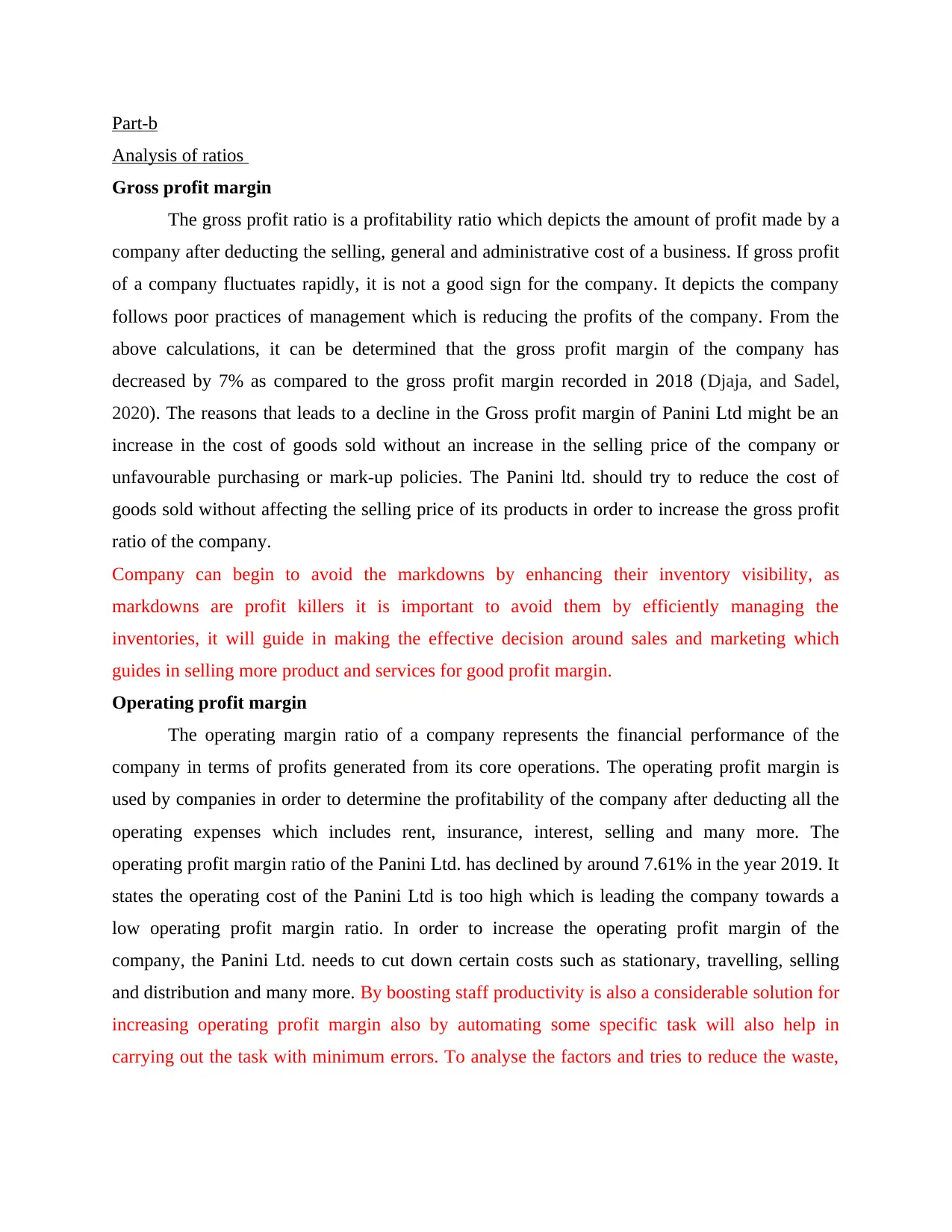
Part-b
Analysis of ratios
Gross profit margin
The gross profit ratio is a profitability ratio which depicts the amount of profit made by a
company after deducting the selling, general and administrative cost of a business. If gross profit
of a company fluctuates rapidly, it is not a good sign for the company. It depicts the company
follows poor practices of management which is reducing the profits of the company. From the
above calculations, it can be determined that the gross profit margin of the company has
decreased by 7% as compared to the gross profit margin recorded in 2018 (Djaja, and Sadel,
2020). The reasons that leads to a decline in the Gross profit margin of Panini Ltd might be an
increase in the cost of goods sold without an increase in the selling price of the company or
unfavourable purchasing or mark-up policies. The Panini ltd. should try to reduce the cost of
goods sold without affecting the selling price of its products in order to increase the gross profit
ratio of the company.
Company can begin to avoid the markdowns by enhancing their inventory visibility, as
markdowns are profit killers it is important to avoid them by efficiently managing the
inventories, it will guide in making the effective decision around sales and marketing which
guides in selling more product and services for good profit margin.
Operating profit margin
The operating margin ratio of a company represents the financial performance of the
company in terms of profits generated from its core operations. The operating profit margin is
used by companies in order to determine the profitability of the company after deducting all the
operating expenses which includes rent, insurance, interest, selling and many more. The
operating profit margin ratio of the Panini Ltd. has declined by around 7.61% in the year 2019. It
states the operating cost of the Panini Ltd is too high which is leading the company towards a
low operating profit margin ratio. In order to increase the operating profit margin of the
company, the Panini Ltd. needs to cut down certain costs such as stationary, travelling, selling
and distribution and many more. By boosting staff productivity is also a considerable solution for
increasing operating profit margin also by automating some specific task will also help in
carrying out the task with minimum errors. To analyse the factors and tries to reduce the waste,
Analysis of ratios
Gross profit margin
The gross profit ratio is a profitability ratio which depicts the amount of profit made by a
company after deducting the selling, general and administrative cost of a business. If gross profit
of a company fluctuates rapidly, it is not a good sign for the company. It depicts the company
follows poor practices of management which is reducing the profits of the company. From the
above calculations, it can be determined that the gross profit margin of the company has
decreased by 7% as compared to the gross profit margin recorded in 2018 (Djaja, and Sadel,
2020). The reasons that leads to a decline in the Gross profit margin of Panini Ltd might be an
increase in the cost of goods sold without an increase in the selling price of the company or
unfavourable purchasing or mark-up policies. The Panini ltd. should try to reduce the cost of
goods sold without affecting the selling price of its products in order to increase the gross profit
ratio of the company.
Company can begin to avoid the markdowns by enhancing their inventory visibility, as
markdowns are profit killers it is important to avoid them by efficiently managing the
inventories, it will guide in making the effective decision around sales and marketing which
guides in selling more product and services for good profit margin.
Operating profit margin
The operating margin ratio of a company represents the financial performance of the
company in terms of profits generated from its core operations. The operating profit margin is
used by companies in order to determine the profitability of the company after deducting all the
operating expenses which includes rent, insurance, interest, selling and many more. The
operating profit margin ratio of the Panini Ltd. has declined by around 7.61% in the year 2019. It
states the operating cost of the Panini Ltd is too high which is leading the company towards a
low operating profit margin ratio. In order to increase the operating profit margin of the
company, the Panini Ltd. needs to cut down certain costs such as stationary, travelling, selling
and distribution and many more. By boosting staff productivity is also a considerable solution for
increasing operating profit margin also by automating some specific task will also help in
carrying out the task with minimum errors. To analyse the factors and tries to reduce the waste,
Paraphrase This Document
Need a fresh take? Get an instant paraphrase of this document with our AI Paraphraser
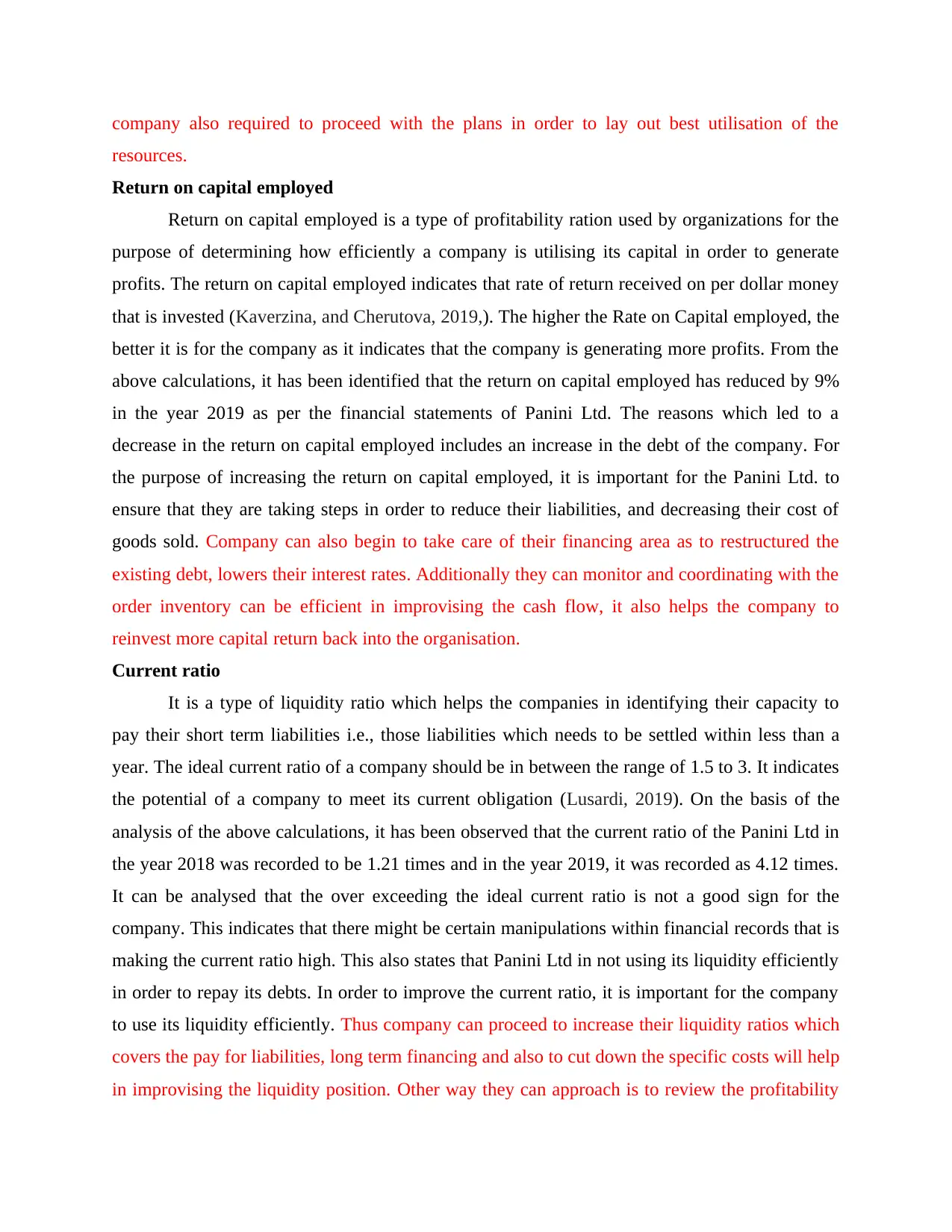
company also required to proceed with the plans in order to lay out best utilisation of the
resources.
Return on capital employed
Return on capital employed is a type of profitability ration used by organizations for the
purpose of determining how efficiently a company is utilising its capital in order to generate
profits. The return on capital employed indicates that rate of return received on per dollar money
that is invested (Kaverzina, and Cherutova, 2019,). The higher the Rate on Capital employed, the
better it is for the company as it indicates that the company is generating more profits. From the
above calculations, it has been identified that the return on capital employed has reduced by 9%
in the year 2019 as per the financial statements of Panini Ltd. The reasons which led to a
decrease in the return on capital employed includes an increase in the debt of the company. For
the purpose of increasing the return on capital employed, it is important for the Panini Ltd. to
ensure that they are taking steps in order to reduce their liabilities, and decreasing their cost of
goods sold. Company can also begin to take care of their financing area as to restructured the
existing debt, lowers their interest rates. Additionally they can monitor and coordinating with the
order inventory can be efficient in improvising the cash flow, it also helps the company to
reinvest more capital return back into the organisation.
Current ratio
It is a type of liquidity ratio which helps the companies in identifying their capacity to
pay their short term liabilities i.e., those liabilities which needs to be settled within less than a
year. The ideal current ratio of a company should be in between the range of 1.5 to 3. It indicates
the potential of a company to meet its current obligation (Lusardi, 2019). On the basis of the
analysis of the above calculations, it has been observed that the current ratio of the Panini Ltd in
the year 2018 was recorded to be 1.21 times and in the year 2019, it was recorded as 4.12 times.
It can be analysed that the over exceeding the ideal current ratio is not a good sign for the
company. This indicates that there might be certain manipulations within financial records that is
making the current ratio high. This also states that Panini Ltd in not using its liquidity efficiently
in order to repay its debts. In order to improve the current ratio, it is important for the company
to use its liquidity efficiently. Thus company can proceed to increase their liquidity ratios which
covers the pay for liabilities, long term financing and also to cut down the specific costs will help
in improvising the liquidity position. Other way they can approach is to review the profitability
resources.
Return on capital employed
Return on capital employed is a type of profitability ration used by organizations for the
purpose of determining how efficiently a company is utilising its capital in order to generate
profits. The return on capital employed indicates that rate of return received on per dollar money
that is invested (Kaverzina, and Cherutova, 2019,). The higher the Rate on Capital employed, the
better it is for the company as it indicates that the company is generating more profits. From the
above calculations, it has been identified that the return on capital employed has reduced by 9%
in the year 2019 as per the financial statements of Panini Ltd. The reasons which led to a
decrease in the return on capital employed includes an increase in the debt of the company. For
the purpose of increasing the return on capital employed, it is important for the Panini Ltd. to
ensure that they are taking steps in order to reduce their liabilities, and decreasing their cost of
goods sold. Company can also begin to take care of their financing area as to restructured the
existing debt, lowers their interest rates. Additionally they can monitor and coordinating with the
order inventory can be efficient in improvising the cash flow, it also helps the company to
reinvest more capital return back into the organisation.
Current ratio
It is a type of liquidity ratio which helps the companies in identifying their capacity to
pay their short term liabilities i.e., those liabilities which needs to be settled within less than a
year. The ideal current ratio of a company should be in between the range of 1.5 to 3. It indicates
the potential of a company to meet its current obligation (Lusardi, 2019). On the basis of the
analysis of the above calculations, it has been observed that the current ratio of the Panini Ltd in
the year 2018 was recorded to be 1.21 times and in the year 2019, it was recorded as 4.12 times.
It can be analysed that the over exceeding the ideal current ratio is not a good sign for the
company. This indicates that there might be certain manipulations within financial records that is
making the current ratio high. This also states that Panini Ltd in not using its liquidity efficiently
in order to repay its debts. In order to improve the current ratio, it is important for the company
to use its liquidity efficiently. Thus company can proceed to increase their liquidity ratios which
covers the pay for liabilities, long term financing and also to cut down the specific costs will help
in improvising the liquidity position. Other way they can approach is to review the profitability
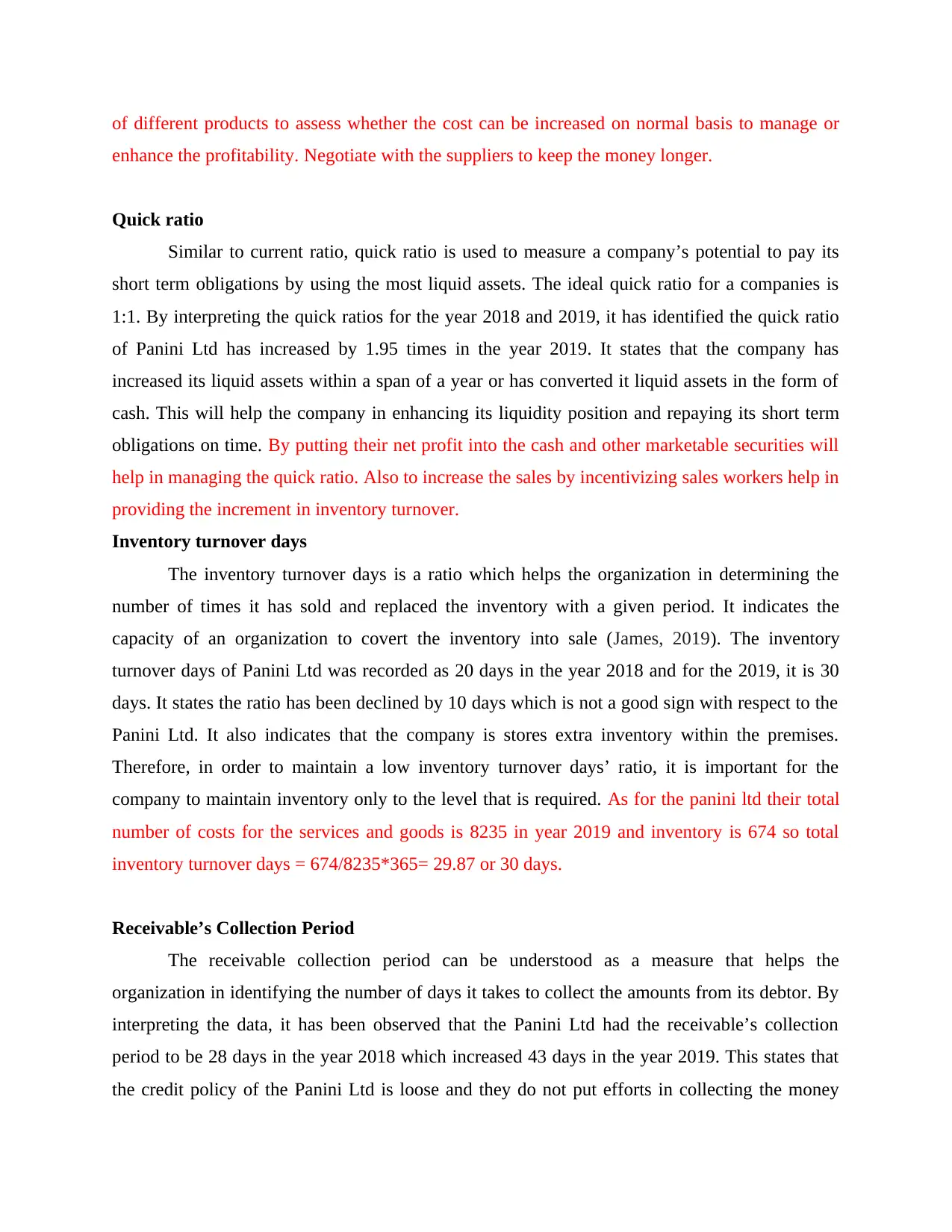
of different products to assess whether the cost can be increased on normal basis to manage or
enhance the profitability. Negotiate with the suppliers to keep the money longer.
Quick ratio
Similar to current ratio, quick ratio is used to measure a company’s potential to pay its
short term obligations by using the most liquid assets. The ideal quick ratio for a companies is
1:1. By interpreting the quick ratios for the year 2018 and 2019, it has identified the quick ratio
of Panini Ltd has increased by 1.95 times in the year 2019. It states that the company has
increased its liquid assets within a span of a year or has converted it liquid assets in the form of
cash. This will help the company in enhancing its liquidity position and repaying its short term
obligations on time. By putting their net profit into the cash and other marketable securities will
help in managing the quick ratio. Also to increase the sales by incentivizing sales workers help in
providing the increment in inventory turnover.
Inventory turnover days
The inventory turnover days is a ratio which helps the organization in determining the
number of times it has sold and replaced the inventory with a given period. It indicates the
capacity of an organization to covert the inventory into sale (James, 2019). The inventory
turnover days of Panini Ltd was recorded as 20 days in the year 2018 and for the 2019, it is 30
days. It states the ratio has been declined by 10 days which is not a good sign with respect to the
Panini Ltd. It also indicates that the company is stores extra inventory within the premises.
Therefore, in order to maintain a low inventory turnover days’ ratio, it is important for the
company to maintain inventory only to the level that is required. As for the panini ltd their total
number of costs for the services and goods is 8235 in year 2019 and inventory is 674 so total
inventory turnover days = 674/8235*365= 29.87 or 30 days.
Receivable’s Collection Period
The receivable collection period can be understood as a measure that helps the
organization in identifying the number of days it takes to collect the amounts from its debtor. By
interpreting the data, it has been observed that the Panini Ltd had the receivable’s collection
period to be 28 days in the year 2018 which increased 43 days in the year 2019. This states that
the credit policy of the Panini Ltd is loose and they do not put efforts in collecting the money
enhance the profitability. Negotiate with the suppliers to keep the money longer.
Quick ratio
Similar to current ratio, quick ratio is used to measure a company’s potential to pay its
short term obligations by using the most liquid assets. The ideal quick ratio for a companies is
1:1. By interpreting the quick ratios for the year 2018 and 2019, it has identified the quick ratio
of Panini Ltd has increased by 1.95 times in the year 2019. It states that the company has
increased its liquid assets within a span of a year or has converted it liquid assets in the form of
cash. This will help the company in enhancing its liquidity position and repaying its short term
obligations on time. By putting their net profit into the cash and other marketable securities will
help in managing the quick ratio. Also to increase the sales by incentivizing sales workers help in
providing the increment in inventory turnover.
Inventory turnover days
The inventory turnover days is a ratio which helps the organization in determining the
number of times it has sold and replaced the inventory with a given period. It indicates the
capacity of an organization to covert the inventory into sale (James, 2019). The inventory
turnover days of Panini Ltd was recorded as 20 days in the year 2018 and for the 2019, it is 30
days. It states the ratio has been declined by 10 days which is not a good sign with respect to the
Panini Ltd. It also indicates that the company is stores extra inventory within the premises.
Therefore, in order to maintain a low inventory turnover days’ ratio, it is important for the
company to maintain inventory only to the level that is required. As for the panini ltd their total
number of costs for the services and goods is 8235 in year 2019 and inventory is 674 so total
inventory turnover days = 674/8235*365= 29.87 or 30 days.
Receivable’s Collection Period
The receivable collection period can be understood as a measure that helps the
organization in identifying the number of days it takes to collect the amounts from its debtor. By
interpreting the data, it has been observed that the Panini Ltd had the receivable’s collection
period to be 28 days in the year 2018 which increased 43 days in the year 2019. This states that
the credit policy of the Panini Ltd is loose and they do not put efforts in collecting the money
⊘ This is a preview!⊘
Do you want full access?
Subscribe today to unlock all pages.

Trusted by 1+ million students worldwide
1 out of 14
Related Documents
Your All-in-One AI-Powered Toolkit for Academic Success.
+13062052269
info@desklib.com
Available 24*7 on WhatsApp / Email
![[object Object]](/_next/static/media/star-bottom.7253800d.svg)
Unlock your academic potential
Copyright © 2020–2025 A2Z Services. All Rights Reserved. Developed and managed by ZUCOL.

